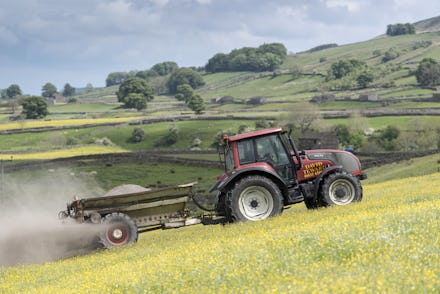How a simple farming method could remove 2 billion tons of carbon from the atmosphere

It has been made abundantly clear that humans need to significantly reduce the amount of greenhouse gas emissions we produce in order to stave off the worst effects of climate change. Another, less talked about element of that process is removing the existing amounts of carbon and other harmful gases that are already in our atmosphere. A new study published Wednesday in the journal Nature suggests that we may already have the tools to do just that. Scientists found that by spreading rock dust on farmlands, we could eliminate billions of tons of carbon dioxide from the atmosphere every year.
The technique used in the study is a process known as enhanced rock weathering (ERW) and involves spreading layers of crushed rock across the soil of farmland. Silicate and carbonate minerals found within the rock particles eventually dissolve when exposed to rainwater. When that happens, the chemical reaction draws carbon dioxide from the atmosphere and stores it in bicarbonate ions. Those bicarbonate ions are carried in water runoff to the ocean, where they form carbonate minerals that can store the carbon indefinitely.
This approach to carbon capture presents a significant amount of promise. First, many farmers already utilize a similar process, adding limestone dust to their soil in order to reduce levels of acidification that would otherwise render the land less friendly to crop growth. Farmers would simply follow the same formula to add other types of rock dust, specifically basalt, which the study determined was the most effective at capturing carbon. This process will have the added benefit of making crops more fertile and improving the overall crop yield. A study published earlier this year in Global Change Biology found some crops saw as much as a 20 percent increase following the ERW technique. This could be an essential benefit, as the effects of climate change threaten farmlands across the world and could result in disruption of the global food supply.
Additionally, the material required for ERW is readily available. Mines produce a significant amount of dust as a byproduct and there are stockpiles of the material ready to be used. Researchers said that similarly useful material is often produced as a byproduct of iron and steel manufacturing and construction and demolition projects, and noted that they are typically just disposed of in landfills. Collecting that byproduct and providing it to farmers for this carbon trapping process would allow those pollution-heavy industries to play a role in reducing their own impact on the environment.
Finally, the countries that are currently among the biggest polluters in the world also happen to be the ones who have the most potential to benefit from ERW. The United States, China, and India are three of the top four producers of carbon emissions globally. They also happen to be the top three countries in terms of cropland available. All three countries also have climates that are relatively warm and tend to speed up the chemical reaction that occurs in ERW to trap carbon.
The researchers believe that if these countries embrace the process, it is possible to remove as much as two billion tons of carbon dioxide from the atmosphere each year. That is in line with the levels of carbon removal called for by the Paris Climate Agreement.
Adopting ERW will require buy-in from farmers and from the biggest polluting countries, but the process presents an accessible short-term solution to carbon sequestration. It can be done almost immediately, while other techniques like planting trees or developing technologies that repurpose existing carbon in the air take time. It's low-hanging fruit that can provide positive outcomes while we continue to work on long-term solutions.